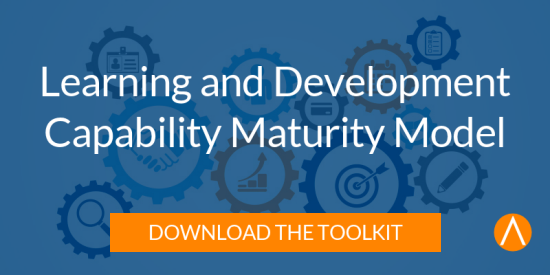Posted by Caveo Learning ● March 31, 2016
L&D Must Gather Stakeholder Feedback to be Better Business Partners
 More likely than not, you believe your learning organization’s measurement and metrics are fully aligned with learning strategy—60% of respondents to a Chief Learning Officer magazine survey last year said as much.
More likely than not, you believe your learning organization’s measurement and metrics are fully aligned with learning strategy—60% of respondents to a Chief Learning Officer magazine survey last year said as much.
Yet we know from many conversations with business leaders that they simply don’t agree. Insufficient and irrelevant metrics is one of the chief complaints business leaders have about the learning and development industry, and while we are making inroads, it’s just not accurate that three out of five L&D organizations are doing measurement well. The external perception of L&D’s value proposition doesn’t mesh with learning leaders’ own assessments.
This isn’t just a thought experiment, either. This misalignment has real-world impacts on L&D’s budget and organizational influence. According to research from Deloitte, as much as two-thirds of all training happens outside of the learning organization. Suffice to say, if L&D were proving its value to the extent that learning leaders seem to think they are, that figure would be flipped.
But this article isn’t about doing metrics better; the perception gap illustrates the importance of soliciting and seriously analyzing feedback from key stakeholders.
Learning leaders have blind spots when it comes to assessing the performance of their L&D organizations and understanding the perceptions of individuals outside the function. (This challenge is hardly unique to L&D, of course, but it perhaps carries outsized significance given L&D’s integral relationships with every other business unit.)
The best way to uncover these blind spots is to get the unvarnished truth from the stakeholders by surveying or interviewing them on a regular basis.
Six Steps to a Meaningful Stakeholder Feedback Process
1. Formulate the questions.
Include a mix of multiple choice, rating, true/false, and open-ended questions, and don’t omit questions just because you think you already know the answer—that’s how those blind spots happen. At the same time, be discerning about the questions you ask, since a longer survey will have a lower response rate. Some questions might include:
- Did we contribute value toward achieving your business goals?
- Did we meet our deadlines?
- Were we easy to work with?
- How do you measure the value of our solutions, and how do these measurements align with your own goals?
- How do you communicate the value of our work to your stakeholders?
There are two other questions that are important as NPS, or net promoter score, questions. You can use NPS questions to watch trends and set goals for long-term improvement:
- How much do you look forward to working with our team again?
- How enthusiastically would you recommend us to your colleagues?
2. Determine the style of feedback solicitation.
Should you conduct a survey, or a series of one-on-one stakeholder interviews? There are benefits to each.
Benefits of an interview:
- Provides the opportunity to dig deeper with follow-up questions
- Allows the interviewer to gauge body language and other nonverbal cues
- Fosters potential for peer collaboration
Benefits of a survey:
- Permits respondents to be anonymous, which encourages honest and constructive feedback
- Demonstrates to stakeholders that you are trying to be more aware of and fix existing gaps
- Accelerates the feedback process, especially for a large group
- Standardizes the feedback and highlights the gaps between perceptions of the internal L&D team and those of your stakeholders
- Illustrates trends over time with multiple surveys
3. Gather the data.
Consider using a neutral third party to conduct the surveys or interviews, especially if the relationship between L&D and certain stakeholders is chilly, as a way to encourage more candid and honest responses. Additionally, have your L&D team take the survey for comparison, which can serve as both a valuable self-evaluation and to illustrate any gaps in internal vs. external perception.
4. Analyze the responses.
Convene a meeting with the senior members of your L&D team and discuss the results as a group, and attempt to identify the root causes of unexpected results. And track feedback across multiple survey periods in an effort to identify and respond to positive or negative trends.
5. Communicate the feedback results and a strategy for addressing shortcomings.
After the survey results are in—or, in the case of interviews, after you have addressed the insights with your team and compared them with your internal efforts—review the findings with the stakeholders and your team. Share themes and trends from the data, and create a plan of action to address gaps. This opens the dialog with stakeholders and lets them know you are taking action on their feedback, and it invites them to be even more candid and honest going forward. Two-way feedback (the feedback loop) is critical to gaining both alignment and future collaboration.
6. Lather, rinse, and repeat.
Do it again in six months. Track and visualize the process your learning organization is making toward being an optimal business partner, and stay on ahead of any emerging weaknesses before they become challenges.
Become a Better Business Partner
Being transparent about the learning organization’s shortcomings shows that you’re serious about being a better business partner, and it also holds L&D accountable for following through with the changes. Just as importantly, this feedback can provide testimonials about the strengths of your L&D organization, which lifts the morale of your team members and serves as evidence of the value proposition being provided.
Topics: Learning Strategy


